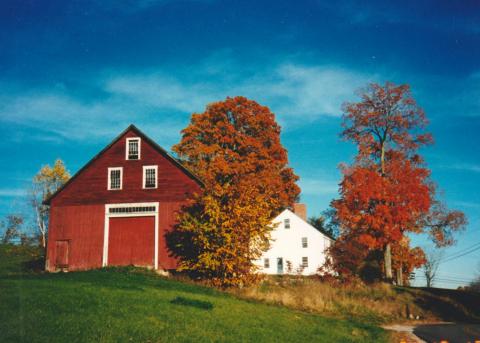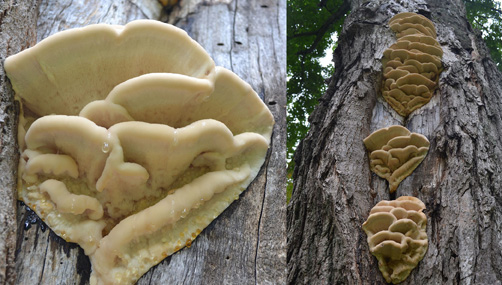Scouting Sugar Maples

Happily, one volunteer activity that I am still able to do during the pandemic restrictions is to measure trees for the NH Big Tree program, following the UNH guidance. With folks working from home, they seem to be more aware of their property, or simply have the time to measure the circumference of their big trees, the information that is needed to submit a nomination.
I have been busy all summer scouting down amazing trees and meeting wonderful tree-lovers. Coincidentally, I had three sugar maple nominations, the iconic tree of NH and New England, renowned worldwide for its eagerly-anticipated spectacular fall color.
The first is in Deering in an overgrown pasture. The trees around the maple are young compared to this mighty old tree that is now the new state champion. A pasture tree, sometimes called a wolf tree, means that it grew in full sun in a former pasture and it typically has a wide and symmetrical canopy. Although there is not much canopy or crown left of this giant, the girth of its trunk is unbelievable.
A healthy hardwood maple of this size could be harvested for wide boards to make fine hardwood furniture as well as flooring and cabinet. Curly maple is especially prized in furniture for its interesting grain pattern.
The second sugar maple nomination is nearby in Lyndeborough in the yard of a historic farmhouse, growing along with other mature maples. They were obviously planted for their economic benefits, as well as cooling shade. The annual spring harvest of maple syrup from this small sugar bush surrounding the house was surely the intent of planting so many sugar maple trees. A mature sap producing tree was probably the first cash crop of a farm year, conveniently at a time when little was happening on a farm. Thirty-two gallons or more of sap are needed to make a gallon of syrup. Keeping the fire going in the sugar shack in March was probably a welcomed, warm job after surviving the cold winter months, not to mention the fun of making maple sugar snow candy.
The last one I measured shades a big, historic farmhouses on a south-facing hill in Temple. The owners said they don’t need air-conditioning – even for our very hot summer. The huge canopy of the tree casts shade over the entire house, and the evaporation of the water released by the leaves cools the air, a process known as transpiration cooling. Sadly, his tree has a deadly fungal disease called northern tooth. The white fungal growth on the trunk is the fruiting body of an internal fungus that attacks the heart or center of the tree, weakening the tree. This fungal growth is temporary like mushrooms and falls off, but the destructive fungus remains active inside the tree, ruining the valuable lumber. No treatment is available so it will die limb by limb.

Sugar maples were often planted as wedding trees for a bride and groom in the front yard their new house, one on each side of the centered front walk. A sweet gift! This farmhouse had one remaining in the front yard. Husband and wife trees were a customary practice in New England. Newly married couples would plant two separate trees near the entrance of the home. One was the husband tree, and the other, the wife tree. They were trees of the same size, and the same species. They grew side by side, without impeding the growth of the other. As you might imagine, many of the trees still stand, while the homes, and in some cases the marriages, have since been razed.

Make time to enjoy the best majestic maples right here in NH. Look for big giants near old farmhouses were saplings have sprouted up in the nearby woods from the seeds of the mature maples planted long ago for syrup and shade. Enjoy!
More on Maples
Sugar maples are sturdy and can live for hundreds of years if growing in the right conditions; away from roads that are harmful because of salt spray and soil compaction. Maples have shallow root systems near the surface so are vulnerable to these threats. Sugar maples are a climax tree, or one of the final tree species in the process of forest succession. They grow in shade, even as seedlings, so sprout and grow under the parent tree. It is hard to transplant a sugar maple into a hot, sunny location, lots of water required.
What we value this time of year is maple’s intense and stunning fall colors; yellow, orange and red. Red maples, or swamp maples, are easily identified by the ‘V’ shape between the leaf lobes while sugar maples have a ‘U’ shape or outline. Red, swamp maples are the first to turn bright red, but red maples growing in uplands turn later. Red maples, true to their name, tend to have a consistent red/crimson color, while the sugars are more varied from pure yellow to orange or red. The contrasts of this bouquet of colors create the stunning fall landscapes.
Nursery trees with cultivar names like Bonfire, Fall Fiesta, Green Mountain are clones developed for their guaranteed fall color. Their leaves tend to turn the same color throughout the tree at the same time with little variation in hue. This can be stunning, but a bit unnatural. Last fall while on a leaf-peeping drive, I drove into a development that had roads lined with the same cultivar of sugar maples at the peak of color. It was a bit unreal, like a painted movie set. A mix of cultivars would have provided more contrast and outline to each tree instead of looking like a huge hedge.
I have successfully transplanted sugar maples growing in the woods around our house, seedlings from the nearby 1700s farm house. After years of waiting for them to grow big enough to show good fall color, they first turn yellow and then show red at the top where they get the full sun. After a few more decades of growth and they will be glorious. For more on why trees grow where they do, go to: https://extension.unh.edu/resources/files/Resource001693_Rep2279.pdf
